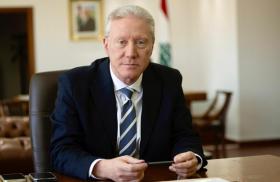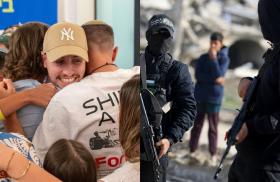
- Policy Analysis
- PolicyWatch 4087
Israel-UAE Defense Cooperation Grows Under the Abraham Accords

Negotiations between Elbit Systems and EDGE Group over the Hermes 900 UAV system exemplify how the accords are ushering in a new era of defense-industrial cooperation.
Since Israel and the United Arab Emirates normalized relations by signing the U.S.-brokered Abraham Accords on September 15, 2020, the two countries have rapidly expanded their economic cooperation and trade, even amid the war in Gaza. Both countries have also committed to working together to “advance security and stability” in the region with the goal of allowing their respective states to prosper. Now, a reported deal in which the UAE’s Edge Group would procure the Hermes 900 unmanned aerial vehicle (UAV) from the Israeli company Elbit Systems—including transfer of technology and localized production—would be the first major defense-industrial partnership between the two countries. If finalized, it would mark a significant step in deepening strategic alignment, defense cooperation, and regional deterrence, potentially shifting the geopolitical balance in the Gulf.
For Washington, this potential deal can serve as a proof of concept for a U.S.-aligned—not U.S.-dependent—security model. More specifically, multilateral air-defense coalitions have become key to the post–October 7 Middle East defense landscape, with countries sharing radar, intelligence, and early warning systems. The challenge for U.S. officials will be encouraging Israel and the UAE to ensure their bilateral agreements can be scaled out to include additional partners when appropriate, while simultaneously ensuring that increased Israel-UAE security cooperation and technology sharing adhere to international export-control regimes. The United States can thus leverage Gulf interest in Israel’s unmatched missile defense capabilities as it encourages Israel to transition away from military campaigns and toward diplomacy—and affirms its support for building regional defense capacity.
From Diplomatic to Defense Normalization
Since 2020, the UAE and Israel have steadily built on their normalized diplomatic and economic ties to expand into the security space, highlighted by these developments:
- November 2021. U.S. Naval Forces Central Command conducts a multilateral maritime exercise in the Red Sea alongside forces from Bahrain, the UAE, and Israel—the first publicly acknowledged military exercise between signatories of the Abraham Accords.
- September 2022. Elbit Systems Emirates, the UAE subsidiary of the Israeli defense firm, announces its award for a $53 million contract to supply defense systems to the Emirati air force, and Israel approves a UAE request to supply the country with the SPYDER mobile air-defense system.
- October 2022. Israeli-made Barak air-defense system deploys to the UAE.
- February 2023. Israel and the UAE announce their first bilateral naval exercise and unveil a jointly developed unmanned maritime vessel.
- April 2025. The UAE sends Mirage 2000-9 fighter jets to join the U.S. and Israeli Air Forces for a multinational exercise in Greece, indicating continued cooperation despite the Gaza war.
Alongside these highlights, the two countries share intelligence regarding common threats and maintain a joint intelligence platform, nicknamed Crystal Ball, which focuses on cybersecurity threats.
With respect to air defense specifically, in 2022, after a series of Iran-aligned-militia missile attacks targeting locations in the UAE, the Gulf country has worked to modernize and expand its defense capabilities. This is where the Hermes 900 comes in. Capable of carrying payloads of up to 660 pounds, it can stay airborne for as many as 30 hours and reach altitudes of 30,000 feet, while conducting missions focused on reconnaissance, surveillance, communications relay, and electronic warfare.
While prioritizing the procurement of specific defense systems, UAE leaders are also pursuing critical technology transfers and localization agreements to bolster their domestic defense industry. A central aspect of the Israel-UAE Hermes 900 agreement is that alongside the purchase of an undisclosed number of drones, it encompasses a phased technology transfer plan leading to eventual domestic production by an EDGE subsidiary. The Hermes blueprint thus could allow the UAE to transform itself from importer to manufacturer—which would realize a critical component of its 2025–28 strategic plan to strengthen its defense sector. This possibility demonstrates how, by legitimizing defense trade and export pathways along with enabling sensitive technology transfers, the Abraham Accords have supported the UAE’s diversification goals and Israel’s expanded position in the Gulf defense market. On the latter count, in 2024 alone, signatories of the accords accounted for 12 percent of Israel’s nearly $15 billion in arms exports.
Regional and Global Implications of Growing Israel-UAE Defense Ties
The growing defense ties between the UAE and Israel carry significant regional—and possibly global—implications, with the potential to alter the Middle East security landscape. If the current deal is realized, Gulf nations like Saudi Arabia and Qatar may see it as a model for diversifying and localizing defense production with preferred partners palatable to Washington, possibly even Israel. Beyond military interoperability and technology transfer, the cooperation signals a strategic shift—one in which realignments are fostered by shared regional security concerns, the need for advanced defense capabilities, and a desire for reduced dependence on traditional suppliers.
The partnership also reflects a broader regional recalibration in the wake of the Abraham Accords, wherein normalization has yielded not just diplomatic but now tangible security and defense-industrial dividends. This evolving cooperation between U.S.-aligned security partners can help accelerate regional defense integration, deepen cooperation in joint initiatives in the tech sector and other areas, and potentially draw additional partners to widen the Middle East security framework. Moreover, such security cooperation could enable expedited fulfillment of UAE and other partner needs from an array of providers.
Yet increased Israel-UAE cooperation also carries risks, such as the possibility of heightening Iran’s threat perception following the twelve-day June war, with its direct U.S. attacks on Iran’s nuclear facilities. Although Abu Dhabi has in recent years pursued a “no enemies” approach to the region and rapprochement with Iran, its burgeoning security cooperation with Jerusalem could unnerve Tehran. Moreover, while the UAE and Bahrain have openly embraced normalization with Israel, other Gulf Cooperation Council (GCC) members like Kuwait, Oman, Qatar, and Saudi Arabia have taken a more cautious approach—given both the Iran challenge and a Gaza war with seemingly no end in sight—and may not want to emulate the deep cooperation pursued by the Emirates. Oman and Kuwait in particular may be concerned that an outsize focus on economic and defense interests could corrode a potentially unified GCC stance as governments work to balance public opinion and political pressures at home. Others, like Turkey and Egypt, may see the current shift as threatening their regional security roles.
Beyond the region, countries like China and Russia may perceive growing Israel-UAE security cooperation as a further consolidation of the U.S.-led regional security architecture designed to limit their influence. Yet while the U.S. rivals may view this as a challenge to their goals, they are unlikely—given sufficient Chinese economic success on the one hand, and various constraints on Russian resources on the other—to alter their engagement approach in the region as a result.
Policy Recommendations
Solidifying the terms of the Hermes deal and subsequent implementation will not be without challenges. In anticipation, the UAE will need to proactively address domestic concerns about cooperation with Israel and increase transparency and confidence-building measures to alleviate regional concerns. Israel, for its part, should structure the deal in order to build long-term trust as a defense supplier, while both casting the UAE as an example for the region and ensuring technology security. The United States, too, has a role, and can take several steps to navigate potential difficulties ahead:
- Work with European allies to encourage Israel-UAE transparency on the Hermes deal, and to align export controls, information security, and military technology standards. Ensuring compliance will mean encouraging Israel to incorporate third-party transfer controls and end-use monitoring safeguard measures.
- Ensure nascent deals are interoperable within the U.S.-led regional security architecture. Then, at the appropriate time, encourage Israel and the UAE to enlist additional partners for security cooperation.
- Support expanded regional security dialogues. In doing so, offer to facilitate discussions on mechanisms that can manage escalation risks.
- Explore localized partnering with regional actors and the U.S. industrial base. This has been a key request of the United States from several Gulf partners, and American companies are struggling to meet this need without solutions from Washington. Israel’s approach to the UAE deal may offer lessons for how the United States can address localization in future deals.
Conclusion
All in all, the likely UAE acquisition of the Hermes 900 drone system from Israel is an important litmus test for post–Abraham Accords defense integration that could potentially affect how normalization expands beyond the diplomatic-economic realm to military-industrial collaboration. It will likely also have broader implications for the Middle East security architecture, demonstrating the significance of shared threat perception, trust, and defense integration, and reshaping the bounds of the possible under normalization. The United States should leverage this potential deal as a proof of concept for a U.S.-aligned, not U.S.-dependent, security model.
Elizabeth Dent is the Nathan and Esther K. Wagner Senior Fellow at The Washington Institute and former director for the Gulf and Arabian Peninsula at the Pentagon.



